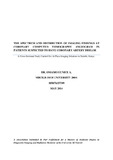| dc.contributor.author | Omamo, Eunice A | |
| dc.date.accessioned | 2014-12-03T09:08:14Z | |
| dc.date.available | 2014-12-03T09:08:14Z | |
| dc.date.issued | 2014 | |
| dc.identifier.uri | http://hdl.handle.net/11295/76026 | |
| dc.description | Thesis Master of Medicine in Diagnostic Imaging and Radiation Medicine | en_US |
| dc.description.abstract | Background
Coronary CT angiography (CCTA) has in the recent past evolved rapidly due to development
of sophisticated multi detector row CT (MDCT).
The cardinal indication for CCTA is the evaluation of suspected or known coronary artery
disease (CAD). Coronary CTA imaging can detect and characterize atherosclerotic plaques.
In addition, it can confirm or exclude luminal stenosis.
Other applications include identification and assessment of variations in coronary arterial
circulation patterns, evaluation of isolated anomalous coronary vessels, by-pass grafts,
coronary stents patency and assessment of left ventricular function.
Study objective: This study was set to determine the spectrum, pattern and distribution of
imaging findings at Coronary CT angiograms as detected by a 320 row MDCT in patients
who had undergone coronary CTA.
Study design: A cross sectional study.
Setting: Plaza Imaging Solutions Limited, Nairobi, Kenya.
Subjects: Patients imaged at Plaza Imaging Solutions Limited over a period of 6 months.
Materials and methods:
Study subjects: Consecutive patients referred for coronary CTA at Plaza Imaging Solutions
Limited and met the inclusion criteria.
Ethical considerations: Ethical approval and clearance was obtained from the KNH-UON
Ethics Review Board. Written and verbal consent was obtained from the participating persons
and/or their kin.
Tools: A two-part data collection form was used to manually record all the relevant data. The
information included socio-demographics, clinical and imaging finding of Coronary CTA.
A low dose calcium scan and a standard coronary CTA were performed. Each Coronary CTA
study was reviewed by a radiologist together with the researcher.
Statistical analysis: Data analysis was performed using the Statistical Package for Social
Sciences (SPSS) employing relevant statistical tests. The results were presented in form of
frequency tables, graphs and charts and discussed accordingly. Statistical significance was set
at p < 0.05 Results
During the 6 month period, 38 out of a total of 42 scanned patients were recruited into the
study. The age distribution ranged from 21 to 89 years with a mean age of 56 years (SD 14.819.2).
Male to female ratio was 5:4
Chest pain (angina) accounted for the commonest indication for imaging at 63.2%.
Risk factors of hypertension and diabetes mellitus were noted in 39.5% of patients. More
males reported a co- morbid state of diabetes mellitus (DM-Type II) while more females 50%
had hypertension.
Overall there were more patients with abnormal scans at 76% than the normal.
Atherosclerotic coronary plaque lesions were the most commonly encountered abnormality
accounting for 93.1%.
The predominant plaque type was the non-calcified plaque seen in 50% of males and 61.5%
of females.
The total calcium scores (Agatston) ranged from 0 to 242.
Calcified plaques were predominantly on the left anterior descending coronary artery (LAD),
while the non-calcified plaques were significant on the right coronary artery (RCA).
Conclusion
The study demonstrated the common occurrence of coronary atherosclerotic plaques in the
older age group with lower incidence seen in younger individuals. It also demonstrated the
wide spectrum of luminal effect caused by the atherosclerotic plaques. Furthermore it
demonstrated the paucity of calcified atherosclerotic plaques amongst the local population
undergoing coronary CTA highlighting the insignificant nature of coronary calcium score in
this setting.
Recommendations
Based on the findings and conclusions of this study, a recommendation is made for coronary
CTA to be performed in the older age group of > 55 years of age with symptomatic features
of ischemic heart disease.
Coronary calcium scoring is not necessary in individuals undergoing coronary CTA in this
setting (black race) as no correlation is found between total calcium score and atherosclerotic
disease burden. | en_US |
| dc.language.iso | en | en_US |
| dc.publisher | University of Nairobi | en_US |
| dc.subject | Coronary artery disease | en_US |
| dc.title | The spectrum and distribution of imaging findings at coronary computed tomography angiogram in patients suspected to have coronary artery disease. A Cross-sectional study carried out at plaza imaging solutions in Nairobi, Kenya | en_US |
| dc.type | Thesis | en_US |
| dc.description.department | a
Department of Psychiatry, University of Nairobi, ; bDepartment of Mental Health, School of Medicine,
Moi University, Eldoret, Kenya | |
| dc.type.material | en_US | en_US |

